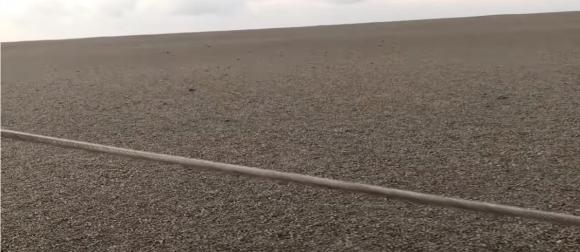
Pacific pumice raft
Back in 2012, we posted about a series of photos that were floating around the internet. The photos were taken from a yacht that had encountered what appeared to be a beach, stretching as far as the eye could see in the middle of the South Pacific. It turned out that what they were seeing was floating pumice, the volcanic rock formed when lava erupts underwater. With a bit more investigation, it appeared that the photos dated back to 2006. At around the same time, the New Zealand Navy reported a pumice raft covering an area of roughly 10,000 square miles.
Recently, the New York Times reported that a couple sailing in the Southwest Pacific encountered a similar pumice raft — a floating mass of volcanic rocks, with some boulders as large as basketballs, blanketing the ocean as far as their boat’s spotlight could illuminate.
The rocks — a raft of pumice estimated to be as large as 200 football fields — transformed the ocean into an opaque, undulating crust. Scientists say the raft resulted from an underwater volcanic eruption near Tonga this month, and it is slowly floating toward Australia.
A giant raft of floating rock is not all that uncommon. Similar rafts occur every five or so years, scientists said, but such masses are rarely encountered up close by people.
The Times article raises one possible upside to these floating pumice islands.
Researchers are curious about whether marine life, hitching a ride on the rocks, might help replenish the Great Barrier Reef, one of the world’s great natural wonders, which has been threatened by consecutive bleaching events in recent years as a result of climate change, and is at risk of eventually dying.
“When the pumice arrives on our shore, it won’t be recognizable,” said Scott Bryan, the geologist who is leading the recovery and analysis of the pumice at the Queensland University of Technology.
The rocks — some no larger than marbles — could be teeming, he said, with marine life including bacteria, algae, barnacles, mollusks, anemones, worms, crabs and it is hoped, corals, along with the organisms that support their growth.
Professor Bryan, who has been studying the effects of underwater volcanic eruptions for two decades, said he hoped corals would arrive in the millions. Even if only 1 percent survive, he said, it could be a blessing for the Great Barrier Reef, which recent studies have shown may not be as resilient as once thought.

One found this extremely interesting having spent 50 years at sea. Quite a bit of that time was spent crossing the Pacific Ocean and trading between numerous Pacific Islands. Also two years were spent living in New Zealand yet never saw or heard of these events occurring.
Good Watch